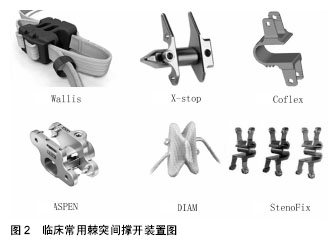| [1] Kaner T, Ozer AF. Dynamic stabilization for challenging lumbar degenerative diseases of the spine: a review of the literature. Adv Orthop. 2013,doi: 10.1155/2013/753470.
[2] 申洪全,汪洋,柯珍勇.腰椎棘突间分离装置应用进展[J]. 现代医药卫生,2014,30(8):1184-1187.
[3] Kabir SM, Gupta SR, Casey AT. Lumbar interspinous spacers: a systematic review of clinical and biomechanical evidence. Spine. 2010;35(25): E1499-E1506.
[4] Gazzeri R, Galarza M, Alfieri A. Controversies about interspinous process devices in the treatment of degenerative lumbar spine diseases: past, present, and future. Bio Med Rese Int. 2014, doi: 10.1155/2014/975052.
[5] Bonaldi G, Brembilla C, Cianfoni A. Minimally-invasive posterior lumbar stabilization for degenerative low back pain and sciatica. A review. Eur J Radiol. 2015; 84(5): 789-798.
[6] Alfieri A, Gazzeri R, Prell J, et al. Role of lumbar interspinous distraction on the neural elements. Neurosurg Rev. 2012;35(4):477-484.
[7] Rolfe KW, Zucherman JF, Kondrashov DG, et al. Scoliosis and interspinous decompression with the X-STOP: prospective minimum 1-year outcomes in lumbar spinal stenosis. Spine J. 2010;10(11): 972-978.
[8] Sénégas J. Mechanical supplementation by non-rigid fixation in degenerative intervertebral lumbar segments: the Wallis system//Arthroplasty of the Spine. Springer Berlin Heidelberg, 2004: 108-113.
[9] 陈宏亮,丁文元.腰椎棘突间非融合技术的研究进展[J]. 中国修复重建外科杂志,2010,24(3): 368-373.
[10] Lafage V, Gangnet N, Sénégas J, et al. New interspinous implant evaluation using an in vitro biomechanical study combined with a finite-element analysis. Spine. 2007;32(16): 1706-1713.
[11] Ilharreborde B, Shaw MN, Berglund LJ, et al. Biomechanical evaluation of posterior lumbar dynamic stabilization: an in vitro comparison between Universal Clamp and Wallis systems. Eur Spine J. 2011;20(2): 289-296.
[12] Lindsey DP, Swanson KE, Fuchs P, et al. The effects of an interspinous implant on the kinematics of the instrumented and adjacent levels in the lumbar spine. Spine. 2003;28(19): 2192-2197.
[13] Richards JC, Majumdar S, Lindsey DP, et al. The treatment mechanism of an interspinous process implant for lumbar neurogenic intermittent claudication. Spine. 2005;30(7): 744-749.
[14] Lee J, Hida K, Seki T, et al. An interspinous process distractor(X-Stop)for lumbar spinal stenosis in elderly patients: preliminary experiences in 10 consecutive cases. J Spinal Disord Tech. 2004;17(1):72-77.
[15] Siddiqui M, Karadimas E, Nicol M, et al. Influence of X-Stop on neural foramina and spinal canal area in spinal stenosis. Spine. 2006;31(25): 2958-2962.
[16] Wan Z, Wang S, Kozánek M, et al. Biomechanical evaluation of the X-stop device for surgical treatment of lumbar spinal stenosis. J Spinal Disord Tech. 2012; 25(7): 374.
[17] Phillips FM, Voronov LI, Gaitanis IN, et al. Biomechanics of posterior dynamic stabilizing device(DIAM) after facetectomy and discectomy. Spine J. 2006;6(6): 714-722.
[18] Anasetti F, Galbusera F, Aziz HN, et al. Spine stability after implantation of an interspinous device: an in vitro and finite element biomechanical study: Laboratory investigation J Neurosurg. 2010;13(5): 568-575.
[19] Tsai KJ, Murakami H, Lowery GL, et al. A biomechanical evaluation of an interspinous device (Coflex device) used to stabilize lumbar spine. Paradigm Spine J. 2006;1: 14.
[20] Kettler A, Drumm J, Heuer F, et al. Can a modified interspinous spacer prevent instability in axial rotation and lateral bending? A biomechanical in vitro study resulting in a new idea. Clin Biomech. 2008;23(2): 242-247.
[21] 祖丹,海涌,云才,等. 腰椎棘突间动态稳定装置Coflex不同置入深度对相邻节段运动范围影响的生物力学研究[J]. 中国脊柱脊髓杂志,2014,24(10): 933-937.
[22] Karahalios DG, Kaibara T, Porter RW, et al. Biomechanics of a lumbar interspinous anchor with anterior lumbar interbody fusion: laboratory investigation. J Neurosurg. 2010;12(4): 372-380.
[23] Kaibara T, Karahalios DG, Porter RW, et al. Biomechanics of a lumbar interspinous anchor with transforaminal lumbar interbody fixation. World Neurosurg. 2010;73(5): 572-577.
[24] Techy F, Mageswaran P, Colbrunn RW, et al. Properties of an interspinous fixation device (ISD) in lumbar fusion constructs: a biomechanical study. Spine J. 2013;13(5): 572-579.
[25] Gonzalez-Blohm SA, Doulgeris JJ, Aghayev K, et al. Biomechanical analysis of an interspinous fusion device as a stand-alone and as supplemental fixation to posterior expandable interbody cages in the lumbar spine: Laboratory investigation. J Neurosurg. 2014; 20(2): 209-219.
[26] Wilke HJ, Drumm J, Häussler K, et al. Biomechanical effect of different lumbar interspinous implants on flexibility and intradiscal pressure. Eur Spine J. 2008; 17(8): 1049-1056.
[27] Hartmann F, Dietz SO, Hely H, et al. Biomechanical effect of different interspinous devices on lumbar spinal range of motion under preload conditions. Arch Orthop Trauma Surg. 2011;131(7): 917-926.
[28] Hirsch C, Breque C, Ragot S, et al. Biomechanical study of dynamic changes in L4–L5 foramen surface area in flexion and extension after implantation of four interspinous process devices. Orthop Traumatol Surg Rese. 2015;101(2): 215-219.
[29] Schilling C, Pfeiffer M, Grupp TM, et al. The effect of design parameters of interspinous implants on kinematics and load bearing: an in vitro study. Eur Spine J. 2014;23(4):762-771.
[30] 刘瑞,徐林,张元智,等. Wallis腰椎非融合系统的有限元分析[J].中国组织工程研究,2012,16(13):2287-2291.
[31] 姚庆强,王黎明,蒋纯志,等. 非融合棘突间撑开器治疗腰椎早期退变性腰痛的三维有限元分析[J]. 中国骨与关节损伤杂志,2008,23(4):292-295.
[32] 王乃国.腰椎棘突间动力固定的三维有限元分析和前瞻性临床研究[D].中国协和医科大学,2010.
[33] 陈肇辉.腰椎棘突间撑开装置的三维有限元分析及临床应用研究[D]. 第二军医大学,2010.
[34] 王冰,于秀淳,周银,等.棘突间动态内固定系统在腰椎间盘退变性疾病中的应用及中期随访结果[J].中国骨与关节杂志,2015,14(3):224-229.
[35] Zheng S, Yao Q, Cheng L, et al. The effects of a new shape-memory alloy interspinous process device on the distribution of intervertebral disc pressures in vitro. J Biomed Res. 2010;24(2): 115-123.
[36] Bowers C, Amini A, Dailey AT, et al. Dynamic interspinous process stabilization: review of complications associated with the X-Stop device. Neurosurg Focus. 2010;28(6): E8.
[37] Barbagallo GM, Corbino LA, Olindo G, et al. The “sandwich phenomenon”: a rare complication in adjacent, double-level X-stop surgery: report of three cases and review of the literature. Spine. 2010;35(3): E96-E100.
[38] Liu HY, Gu AQ, Zhu ZQ, et al. The efficacy and complication analysis of interspinous dynamic device (Wallis) in patients of degenerative lumbar disease. Zhonghua wai ke za zhi. 2012;50(9): 788-791.
[39] Kaulhausen T, Zarghooni K, Stein G, et al. The interspinous spacer: a clinicoanatomical investigation using plastination. Minim Invasive Surg. 2012;2012: 538697.
[40] Maida G, Marcati E, Sarubbo S. Heterotopic ossification in vertebral interlaminar/interspinous instrumentation: report of a case. Case Rep Surg. 2012;2012:970642.
[41] Barz T, Lange J, Melloh M, et al. Histomorphometric and radiographical changes after lumbar implantation of the PEEK nonfusion interspinous device in the BB. 4S rat model. Spine. 2013;38(5): E263-E269.
[42] Epstein N. A review of interspinous fusion devices: High complication, reoperation rates, and costs with poor outcomes. Surg Neurol Int. 2012; 3: 7.
[43] Tuschel A, Chavanne A, Eder C, et al. Implant survival analysis and failure modes of the X-Stop interspinous distraction device. Spine. 2013;38(21): 1826-1831.
[44] Kim DH, Tantorski M, Shaw J, et al. Occult spinous process fractures associated with interspinous process spacers. Spine. 2011;36(16): E1080-E1085. |
.jpg)


.jpg)
.jpg)